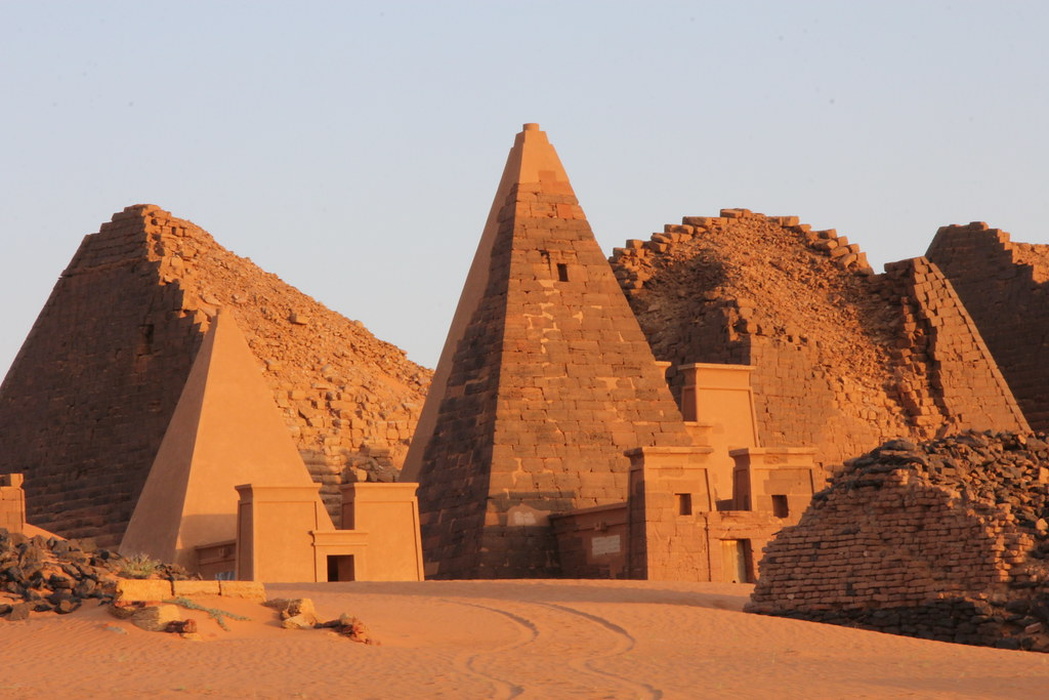Ancient Africa
 Add image to section
Add image to section
Nubia
Nubia is the name of the region along the River Nile from south of Aswan in southern Egypt to the confluence of the Blue and White Niles in Khartoum in central Sudan. It was home to one of the earliest civilizations of ancient Africa, the Kingdom of Kerma, which lasted from around 2500 BC until its conquest by the New Kingdom of Egypt under Pharaoh Thutmose I in around 1500 BC. During this time, relations between the Egyptians and Nubians were largely peaceful, with trade and marriages between the two peoples. The Egyptians imported gold, incense, ebony, copper, ivory and live animals from tropical Africa through Nubia.

The Nubians gained the upper hand over Egypt in the 8th century BC when the Nubian Kingdom of Kush conquered Egypt and ruled it as its 25th Dynasty. Centuries later, from the 3rd century BC to 3rd century AD, northern Nubia was invaded and annexed by Egypt, then ruled by the Greeks and, later, the Romans.

Meroë, located on the east bank of the Nile about 200 kilometres (125 miles) northeast of present-day Khartoum, was the capital of the Kingdom of Kush, one of the greatest civilizations of ancient Africa. It ruled supreme for several centuries, from around 590 BC until its collapse in around 350 AD when Kush fell to the Kingdom of Aksum. The site of the city of Meroë is today marked by more than 200 pyramids, of which many are in ruins.

Kush's wealth at this time, known as the Meriotic period, came from its rich gold reserves (the name "Nubia" may have come from the Egyptian word for gold, nub), its iron industry and trade with lands as far away as India and China. Meroë exported ivory, slaves, animal skins, cotton, jewellery, ostrich feathers, copper and ebony.
Three Christian kingdoms, Nobatia, Makuria and Alodia succeeded the Kingdom of Kush. The latter two lasted for hundreds of years before eventually coming under Muslim rule in 1272.
 Add image to section
Add image to section
Bantu migrations

Bantu is the name given to a group of languages that has its origins in the Niger and Congo regions of west Africa. Around 2000 BC, these peoples began to spread out to the south and east, slowly migrating across the whole of Africa that lies south of the equator. Historians think this expansion probably began on the highlands between Cameroon and Nigeria. The Bantu peoples took with them knowledge about growing crops and working iron.

The Bantu migrations are believed to have taken place in three waves. In the first wave, small groups began to migrate into Central Africa, and then across to the Great Lakes region of East Africa between around 2000 and 1000 BC. This may have been due to the exhaustion of farmland, grazing land and forests in their homeland.
In the second wave, after about 1000 BC, two streams—the West Bantu (from southern West Africa) and the East Bantu (from the Great Lakes region)—moved south. A third wave of migration took place between around 1 and 500 AD as the East Bantu moved further south into Zimbabwe, Botswana and Mozambique. They may have reached southern Africa by around 200 AD.
 Add image to section
Add image to section
Nok culture

The earliest examples of African sculpture were found at Nok in Nigeria. These terracotta heads and figures date from between 500 BC and AD 200. They may have inspired artists of a later civilization at Ife in Nigeria. The Nok people found out about ironworking in around 400 BC, probably from traders crossing the Sahara Desert. Iron was perfect for making axes (which were used for felling trees) and farming tools. It was smelted (separated from the rock) in a clay furnace. Bellows were used to make the fire hot enough to melt the iron. The molten metal ran into a pit underneath the fire.
Among the earliest forms of art in Africa are paintings left on rocks in the Sahara Desert in around 8000 BC. At this time, the Sahara was a green and fertile region. Bands of hunter-gatherers lived there, hunting wild animals to eat and gathering plants. As the Sahara dried up, they moved away. Some went east to found the ancient Egyptian civilization. Others moved south. By about 1000 BC, some people in north and west Africa had learned to mine and work metals such as bronze and iron. As they spread across Africa, they took this knowledge with them.

Added to
People who voted for this also voted for
Western Movie Posters: Jack Hoxie
Leo Babauta's Non-Fiction Recommendations '08
My Favorite Music - Part I - Eminem
Mayer M Flaks
Favourite DVDs
Favourite DVDs
LIVROS - wanted
Olympics
- Instrumental Music
2013 Film Diary
Top films of 1995
MPB Pop Art
Czech music artist
Czech and Slovak music artist
Food Network
More lists from Milena
Latest funny animal compilation!
Message in a bottle, cat edition?
Stunning Digital Art works and Game Character ...
Famous People Born in 1963
Tv Guide - July 12 2012
Amazing and famous anime boy pictures
Quick Breakfast
 Login
Login
























